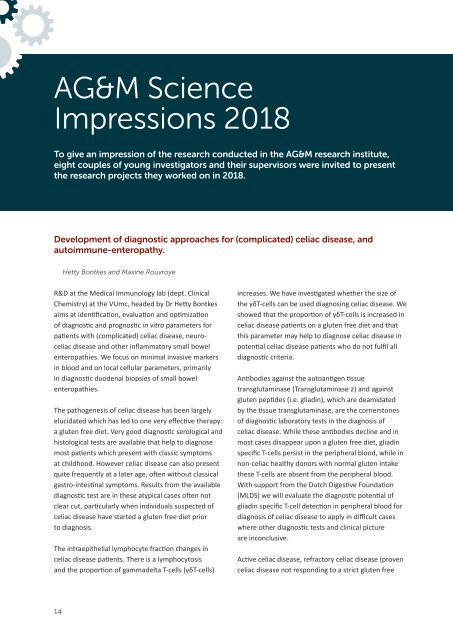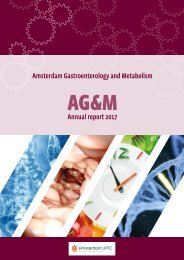AG&M annual report 2018
You also want an ePaper? Increase the reach of your titles
YUMPU automatically turns print PDFs into web optimized ePapers that Google loves.
AG&M Science<br />
Impressions <strong>2018</strong><br />
To give an impression of the research conducted in the AG&M research institute,<br />
eight couples of young investigators and their supervisors were invited to present<br />
the research projects they worked on in <strong>2018</strong>.<br />
Development of diagnostic approaches for (complicated) celiac disease, and<br />
autoimmune-enteropathy.<br />
Hetty Bontkes and Maxine Rouvroye<br />
R&D at the Medical Immunology lab (dept. Clinical<br />
Chemistry) at the VUmc, headed by Dr Hetty Bontkes<br />
aims at identification, evaluation and optimization<br />
of diagnostic and prognostic in vitro parameters for<br />
patients with (complicated) celiac disease, neuroceliac<br />
disease and other inflammatory small bowel<br />
enteropathies. We focus on minimal invasive markers<br />
in blood and on local cellular parameters, primarily<br />
in diagnostic duodenal biopsies of small bowel<br />
enteropathies.<br />
The pathogenesis of celiac disease has been largely<br />
elucidated which has led to one very effective therapy:<br />
a gluten free diet. Very good diagnostic serological and<br />
histological tests are available that help to diagnose<br />
most patients which present with classic symptoms<br />
at childhood. However celiac disease can also present<br />
quite frequently at a later age, often without classical<br />
gastro-intestinal symptoms. Results from the available<br />
diagnostic test are in these atypical cases often not<br />
clear cut, particularly when individuals suspected of<br />
celiac disease have started a gluten free diet prior<br />
to diagnosis.<br />
The intraepithelial lymphocyte fraction changes in<br />
celiac disease patients. There is a lymphocytosis<br />
and the proportion of gammadelta T-cells (γδT-cells)<br />
increases. We have investigated whether the size of<br />
the γδT-cells can be used diagnosing celiac disease. We<br />
showed that the proportion of γδT-cells is increased in<br />
celiac disease patients on a gluten free diet and that<br />
this parameter may help to diagnose celiac disease in<br />
potential celiac disease patients who do not fulfil all<br />
diagnostic criteria.<br />
Antibodies against the autoantigen tissue<br />
transglutaminase (Transglutaminase 2) and against<br />
gluten peptides (i.e. gliadin), which are deamidated<br />
by the tissue transglutaminase, are the cornerstones<br />
of diagnostic laboratory tests in the diagnosis of<br />
celiac disease. While these antibodies decline and in<br />
most cases disappear upon a gluten free diet, gliadin<br />
specific T-cells persist in the peripheral blood, while in<br />
non-celiac healthy donors with normal gluten intake<br />
these T-cells are absent from the peripheral blood.<br />
With support from the Dutch Digestive Foundation<br />
(MLDS) we will evaluate the diagnostic potential of<br />
gliadin specific T-cell detection in peripheral blood for<br />
diagnosis of celiac disease to apply in difficult cases<br />
where other diagnostic tests and clinical picture<br />
are inconclusive.<br />
Active celiac disease, refractory celiac disease (proven<br />
celiac disease not responding to a strict gluten free<br />
14



